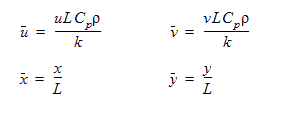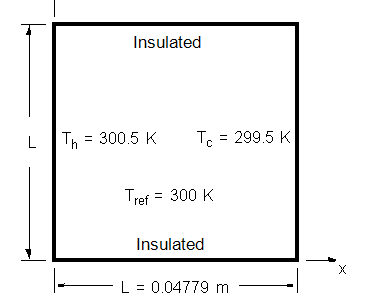Analysis Characteristics
- Steady-state
- 2D internal flow
- Laminar
- Incompressible
- Natural convection
Reference
Davis, G. De Vahl and Jones, I.P., “Natural convection in a square cavity: a comparison exercise”, Inter. Jour. for Num. Meth. in Fluids, 3, (1983).
Problem Description
Temperature and velocity distributions are calculated for laminar, buoyancy-driven flow in a square cavity. The top and bottom walls are insulated, and the left and right walls are at fixed temperatures differing by 1 K.
The Rayleigh number is computed from:

-
 is the coefficient of volumetric expansion, defined as:
is the coefficient of volumetric expansion, defined as:

- g is the acceleration of gravity
-
 is the density
is the density
-
 is the specific heat
is the specific heat
- L is the length of the cavity
-
 and
and
 are the temperatures of the left and right walls, respectively
are the temperatures of the left and right walls, respectively
- k is the conductivity of the fluid
-
 is the viscosity.
is the viscosity.
- Here, the Rayleigh number is 10,000.
This problem is analyzed to verify the fluid flow and heat transfer modeling capabilities of Autodesk® CFD. Accuracy is assessed by comparing velocity components at specific locations in the cavity. Velocities and coordinates are normalized in accordance with Davies, et al. (1983) as follows:

Geometry and Boundary Conditions

Results
Using the expressions defined above for
 ,
,
 ,
,
 and
and
 , the following results are computed:
, the following results are computed:
| Benchmark | 2016: Build 20150209 | % Error | 2017: Build 20160302 | % Error | |

|
16.178 | 15.907 | 1.673 | 15.878 | 1.850 |

|
0.823 | 0.826 | 0.404 | 0.826 | 0.404 |

|
19.617 | 19.538 | 0.402 | 19.521 | 0.486 |

|
0.119 | 0.115 | 3.132 | 0.117 | 1.653 |